- Published on
Notes on Ads Auctions at Meta
Disclaimer: These are notes I took while reading publicly available sites from Meta and YouTube videos.
The ad auction is where your ads compete with other ads trying to reach the same audience. Ads succeed based on their bids, budget and how relevant the ad is to its audience
Ads are displayed on Meta technologies (i.e., Facebook, Messenger, Instagram or Meta Audience Network).
Ads Manager: link.
Budgets
A budget (link) upper bounds the total amount one wants to spend on promoting its ads.
Two types of budgets an advertiser can choose from (link):
Campaign budgets: The budget for the entire ad campaign (consists of multiple ad sets).
This budget is automatically distributed (in real time) to ad sets, using Meta Advantage.
This budget has flexibility to spend more on ad sets with the best opportunities, and less on underperforming ad sets.
Ad set budgets: The budget for an individual ad set, chosen manually by an advertiser.
For both types of budgets, an advertiser can decide if the budget applies to each day or the entire duration:
Lifetime budgets: A hard upper bound on the total amount spent over an ad’s entire duration. The daily spending will be flexible, controlled by Meta (Link).
To get the best results for your budget, we may spend more on days when better opportunities are available, and less on days with fewer opportunities.
Daily budgets: An expected upper bound on the daily amount, averaged over an ad’s duration (link).
 An example of a daily budget of 20.
An example of a daily budget of 20.
Auctions and bidding
Link 1; Link 2; Link 3; Link 4
Each time there's an opportunity to show an ad to someone, an auction takes place to determine which ad to show to that person.
Audiences and goals
An advertiser can specify target audiences when creating an ad. When there is an opportunity to show an ad to a user, ads with the right target audience are eligible for the auction.
An advertiser can also specify a performance goal when creating an ad set. Based on the performance goal, different bidding strategies will be used by Meta. Such goals include maximizing:
Number of landing page views
Number of link clicks
Daily unique reach
Number of conversions
Number of impressions
Winners
The ad with the highest total value (bid, estimated action prob., and ad quality) wins.
Bidding strategies
Meta does auto-bidding (even if a bid cap can be set by an advertiser). There are five (as of 12/15/2024) bidding strategies:
Highest volume: Meta's auto-bidder aims to spend the entire (allocated) budget and get the most results (e.g., num of conversions).
Highest value: Spend the entire budget to maximize the the value of conversions (i.e., revenue for an advertiser).
Cost per result goal: An advertiser sets an expected value of cost per action (CPA), then auto-bidders try to maximize the goal while keeping the averaged spending not too far from this expected value.
Return on ad spend (ROAS): An advertiser can set a target purchase-to-budget ratio (i.e., the return). Auto-bidders then try to beat this ratio within the budget.
For all the strategies given above, an auto-bidder tries to achieves the goal dynamically without capping the maximum amount that can be spent in a single auction (of course, this amount cannot be more than the daily budget).
- Bid cap: An advertiser sets a hard upper bound on the maximum bid for any single auction. An auto-bidding then dynamically bids to maximize the goal, while not exceeding this cap.
Note: Based on the performance goal chosen, only a subset of bidding strategies are feasible. The best practice is to create a campaign using Meta Ads Manager and see different options.
Examples:
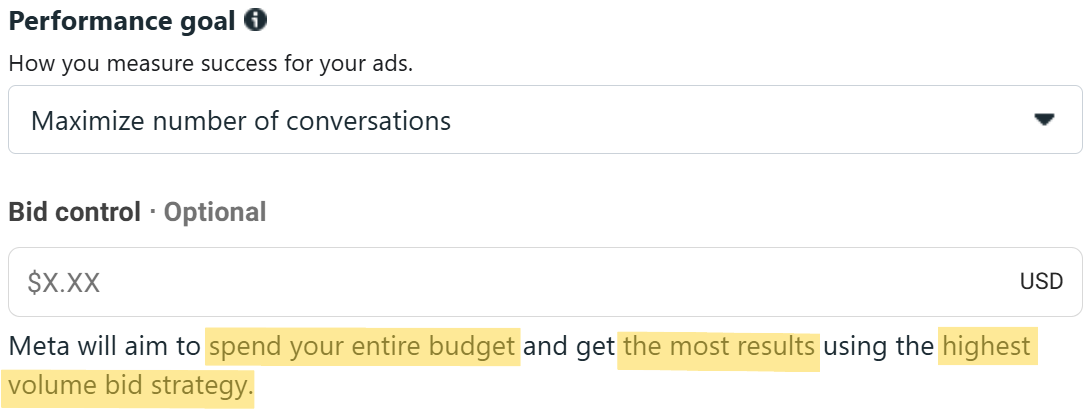
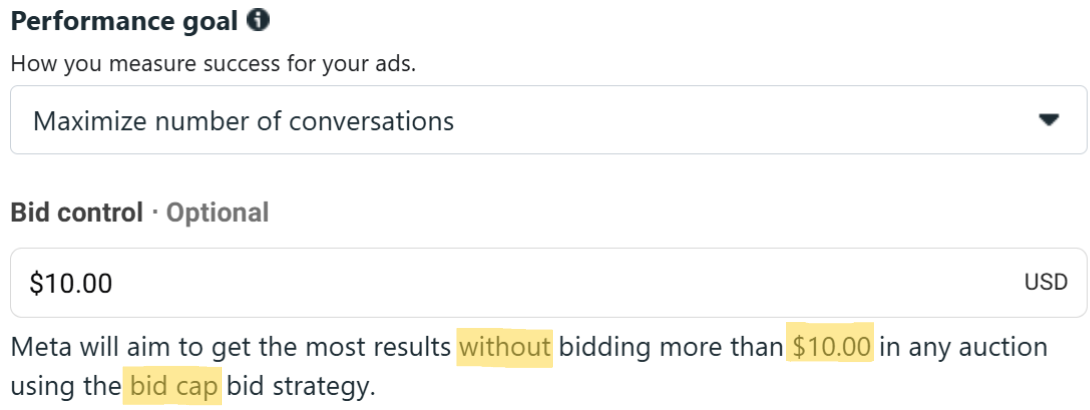 When the goal is to maximize number of conversions, we can use either highest volume or bid cap.
When the goal is to maximize number of conversions, we can use either highest volume or bid cap.
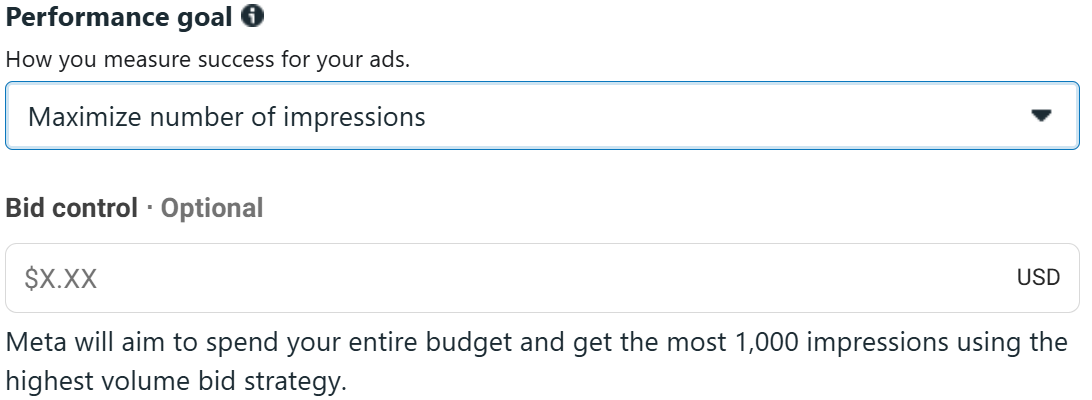 When the goal is to maximize number of impressions, we can use either highest volume or bid cap.
When the goal is to maximize number of impressions, we can use either highest volume or bid cap.
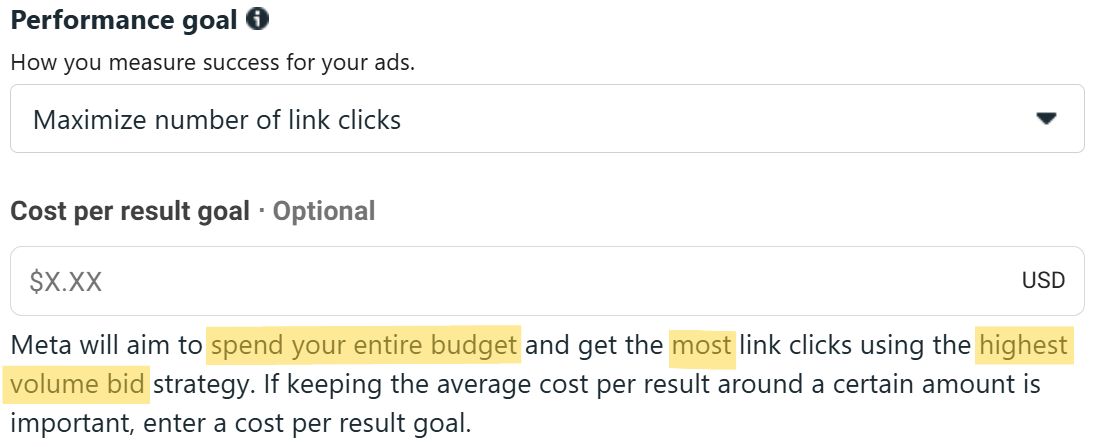
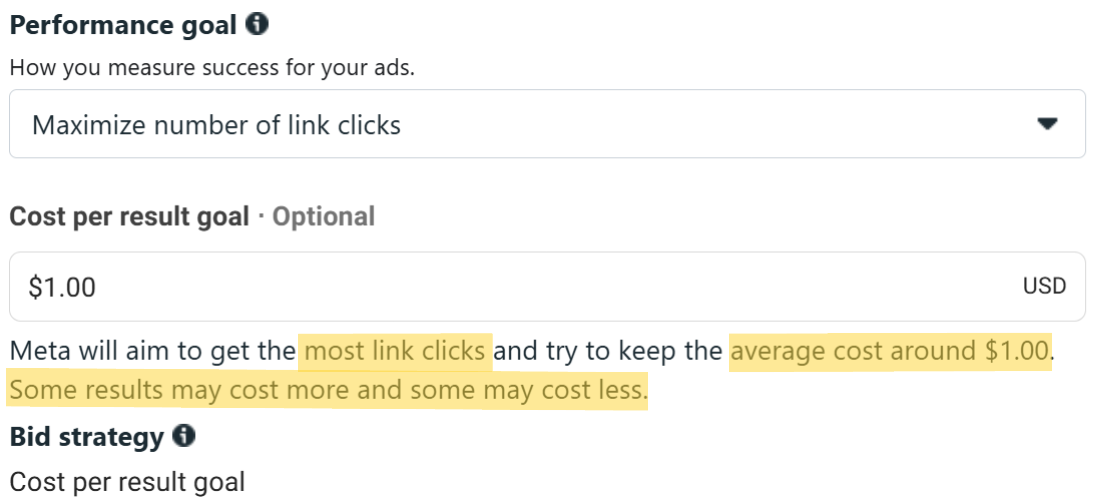 When the goal is to maximize number of link clicks, we can use either highest volume or cost-per-goal.
When the goal is to maximize number of link clicks, we can use either highest volume or cost-per-goal.
Summary
You control your overall amount spent through your budget. You control your cost per result through your bid strategy.